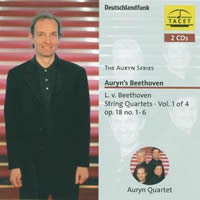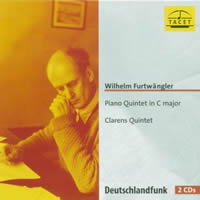The Best Kind of Attitude: TACET
|
Mike Silverton [July 2004.] Some while ago, perhaps a few months, I requested review CDs from TACET, a German label with which I’d little familiarity. Having listened several times over to Beethoven’s six Op.18 String Quartets (TACET 124) and Wilhelm Furtwängler’s Piano Quintet (TACET 119), as a music lover and audiophile (in close to equal measure), I’m here to shout “Eureka!”
The Auryn String Quartet (Mathias Lingfelder, Jens Oppermann, violins; Stewart Eaton, viola; Andreas Arndt, cello) tend toward a Classical rather than Romantic sensibility. The later quartets have yet to be released. Whether the Auryn’s posture changes remains to be heard. With respect to Op.18’s half-dozen, the players operate as a coherent, elegantly articulating being, declining to milk the tender moments dry. Similarly, the sturm und drang passages are handled with a distancing poise that satisfies. Proportionality reigns. These are cool, beautiful performances relating in a fascinating way to journalist Ulrich Oesterle’s statement below regarding production aims.
In order to discuss via contrast TACET’s thoughts on performance and sound — for the audiophile, the most engaging of subjects — we have Furtwängler’s outré Piano Quintet, with the Clarens Quintet (Gernot Süssmuth, Eva Schönweiss, violins; Felix Schwartz, viola; Andreas Greger, cello; Sebastian Krahnert, piano). Bruckner would have approved. The music is huge. You can substitute bloated without inflicting harm. The harmonic idiom looks more to late-19th-century decadence than the time of the quintet’s eventual conclusion, the mid-1930s, though here one might argue otherwise. In any event, as I hear them, the music’s salient endearments are those of an uneasy, Guinness-Book coitus. Quite apart from the usual marks of production excellence — exemplary transparency, dynamic detail, timbral accuracy, harmonic complexity and a soundstage befitting the ensemble’s size — we discover taste. The recording venue for both two-disc sets is DeutschlandRadio’s Funkhaus Köln, with its superior acoustics. The Furtwängler’s milieu is decidedly more humid than that of the Beethoven quartets. My guess is that the hardware was tweaked, with great success, to suit the music’s style and needs. Let me turn this over to Ulrich Oesterle:
Contact http://www.proclassics.de/ or hoogenvd@aol.com. [Walt Mundkowsky adds these thoughts and information:]
[Johann Sebastian BACH: Die Kunst der Fuge, BWV 1080. Evgeni Koroliov, Ljupka Hadzigeorgieva (piano). TACET 13 (2 CDs, 40:09 + 43:42). The star of the TACET roster is likely émigré Russian pianist Evgeni Koroliov. His 1990 studio performance of Bach’s fugal testament ranks among the glories of the catalog (it’s György Ligeti’s Desert Island Disc). The twist of focus Bach on the piano usually requires isn’t a factor. Indeed, the instrument can even be favored in such abstract music, as the keyboard sound most familiar to us — what Charles Rosen suggested. His playing (on Sony SB2K 63231) of course makes a stronger case yet. Describing why Koroliov astounds isn’t easy. His virtuoso technique seems to vanish inside the music — no curious articulations, dynamics or tempos. The spare pedaling never imitates a harpsichord. Similarly, the recording projects a beautifully focused piano — the whole, not a mass of disembodied details. For The Art of Fugue fanciers: Koroliov inserts the canons along the entire span, rather than doing them as a group; and he plays the great unfinished fugue without supplying his own resolution. In an appendix, he and Ljupka Hadzigeorgieva (his duo partner) deliver two fugues for two keyboards (outtakes of Contrapunctus 13). Anyone who cares about this monumental summa — not as a theoretical exercise, but as a living work — has to have this set. TACET’s US distributor is Spinning Dog Records (http://www.spinningdogrecords.com/). Or the discs can be ordered from Germany on the company website (http://www.tacet.de/).]
[More Mike Silverton]
[Previous Article:
A Surprise in 'Most Every Box]
[Next Article:
Ten Poems]
|


